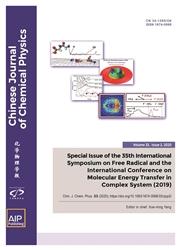Solvent effects on excited-state relaxation dynamics of paddle-wheel BODIPY-Hexaoxatriphenylene conjugates: Insights from non-adiabatic dynamics simulations
IF 1.2
4区 化学
Q4 PHYSICS, ATOMIC, MOLECULAR & CHEMICAL
引用次数: 0
Abstract
Understanding the excited state dynamics of donor-acceptor (D-A) complexes is of fundamental importance both experimentally and theoretically. Herein, we have first explored the photoinduced dynamics of a recently synthesized paddle-wheel BODIPY-hexaoxatriphenylene (BODIPY is the abbreviation for BF2-chelated dipyrromethenes) conjugates D-A complexes with the combination of both electronic structure calculations and non-adiabatic dynamics simulations. On the basis of computational results, we concluded that the BODIPY-hexaoxatriphenylene (BH) conjugates will be promoted to the local excited (LE) states of the BODIPY fragments upon excitation, which is followed by the ultrafast exciton transfer from LE state to charge transfer (CT). Instead of the photoinduced electron transfer process proposed in previous experimental work, such a exciton transfer process is accompanied with the photoinduced hole transfer from BODIPY to hexaoxatriphenylene. Additionally, solvent effects are found to play an important role in the photoinduced dynamics. Specifically, the hole transfer dynamics is accelerated by the acetonitrile solvent, which can be ascribed to significant influences of the solvents on the charge transfer states, i.e. the energy gaps between LE and CT excitons are reduced greatly and the non-adiabatic couplings are increased in the meantime. Our present work not only provides valuable insights into the underlying photoinduced mechanism of BH, but also can be helpful for the future design of novel donor-acceptor conjugates with better optoelectronic performance.溶剂对桨轮BODIPY-六氧杂三苯基偶联物激发态弛豫动力学的影响:非绝热动力学模拟的启示
了解供体-受体(D-A)配合物的激发态动力学在实验和理论上都具有重要意义。在此,我们首次结合电子结构计算和非绝热动力学模拟,探索了最近合成的桨轮BODIPY六氧杂三苯基(BODIPY是BF2螯合二吡咯甲烷的缩写)偶联物D-a配合物的光致动力学。基于计算结果,我们得出结论,BODIPY六氧杂三苯基(BH)偶联物在激发时将被促进到BODIPY片段的局部激发(LE)态,随后是从LE态到电荷转移(CT)的超快激子转移。与先前实验工作中提出的光诱导电子转移过程不同,这种激子转移过程伴随着从BODIPY到六氧杂三苯基的光诱导空穴转移。此外,发现溶剂效应在光诱导动力学中起着重要作用。具体而言,乙腈溶剂加速了空穴转移动力学,这可归因于溶剂对电荷转移态的显著影响,即LE和CT激子之间的能隙大大减小,同时非绝热耦合增加。我们目前的工作不仅为BH的潜在光诱导机制提供了有价值的见解,而且有助于未来设计具有更好光电性能的新型供体-受体偶联物。
本文章由计算机程序翻译,如有差异,请以英文原文为准。
求助全文
约1分钟内获得全文
求助全文
来源期刊

Chinese Journal of Chemical Physics
物理-物理:原子、分子和化学物理
CiteScore
1.90
自引率
10.00%
发文量
2763
审稿时长
3 months
期刊介绍:
Chinese Journal of Chemical Physics (CJCP) aims to bridge atomic and molecular level research in broad scope for disciplines in chemistry, physics, material science and life sciences, including the following:
Theoretical Methods, Algorithms, Statistical and Quantum Chemistry
Gas Phase Dynamics and Structure: Spectroscopy, Molecular Interactions, Scattering, Photochemistry
Condensed Phase Dynamics, Structure, and Thermodynamics: Spectroscopy, Reactions, and Relaxation Processes
Surfaces, Interfaces, Single Molecules, Materials and Nanosciences
Polymers, Biopolymers, and Complex Systems
Other related topics
 求助内容:
求助内容: 应助结果提醒方式:
应助结果提醒方式:


